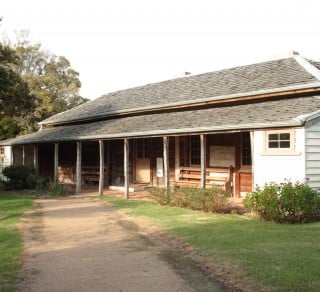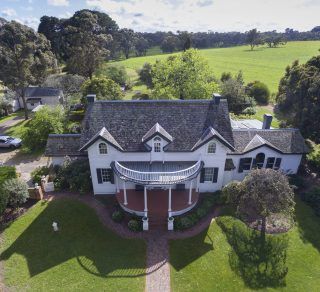Written by Fiona Gruber. This article was first published in the National Trust of Australia (Victoria) Magazine (Spring 2022 issue).
On a recent visit to the National Trust-run home of Thomas and Jane Carlyle in London’s Chelsea, three things became apparent; one, that it was the home of two very talented and influential Victorians, one of whom, Thomas, was a brilliant historian and philosopher and the other a celebrated letter-writer; two, that they didn’t pay enough attention to the needs of the servants, who had to heat and lug bath water up four flights of stairs for each of them twice a day, as they didn’t believe in indoor plumbing; and three, that they were prickly people with a frequently fractious relationship. The contemporaneous writer Samuel Butler once wrote “It was very good of God to let Carlyle and Mrs Carlyle marry one another and so make only two people miserable instead of four.”
House museums allow a glimpse into the domestic sphere that is unique and privileged. As Virginia Woolf, in her essay ‘Carlyle’s House’ observed, one hour in No.5 Cheyne Row would tell you more about the couple than all the biographies.
The National Trust of Australia’s Victorian collection of houses offer similar insights for those wanting to get below the surface of public lives.
Mulberry Hill, the former home of the writer Joan Lindsay and her husband, artist and gallery director Daryl Lindsay, is one of them.
Joan Lindsay claimed to have the unnerving ability to stop machinery whenever she approached. It has been conjectured that this is one of the reasons she called her autobiography Time Without Clocks. Apparently, they would stop ticking whenever she was near.
Less disconcertingly, the title also alludes to the period of her early marriage at Mulberry Hill, a time of carefree creativity.
Mulberry Hill was an old farmhouse in Langwarrin South on the Mornington Peninsula that the couple discovered in the mid-1920s. It was their dream home, but they employed the fashionable architect Harold Desbrowe-Annear to rebuild it in the American Colonial style, with weatherboard walls, a curved portico, shutters, and a tiled roof.
It was completed in 1926 and, except for an unhappy period during the Great Depression of the early 1930s when they had to rent it out, they lived there intermittently until Joan Lindsay’s death in 1984 (Daryl Lindsay had died eight years earlier). It is where Joan wrote most of her novels and plays including the internationally famous Picnic at Hanging Rock, which she completed in four weeks, and which was published in 1967. With no children to inherit the property, they left it to the National Trust.
Daryl Lindsay, as well as being the National Gallery of Victoria’s first director between 1941 and 1956, was a co-founder and first president of the National Trust of Australia (Victoria).
He understood the importance of preserving smaller properties as well as the grander homes of the squattocracy and merchant princes.
In the case of Mulberry Hill, there is a certain thrill of being in a space where two highly gifted individuals spent their time creating and entertaining. There’s Joan Lindsay’s typewriter; did the keys ever jam in a paranormal way, one wonders? And Daryl Lindsay’s studio, remarkably intact, reminds one that he came from a family of painters, including his brothers Lionel, Percy and Norman Lindsay and sister Ruby. The place is full of lovely artwork, objects, and furniture, shabby, comfortable, very much as they left it, and it feels as if they may have just strolled off for a walk with some visiting friends.
Down the road and 100 years earlier, Georgiana McCrae lived at the homestead that bears her and her husband Andrew’s name. This talented painter and fascinating chronicler of early Melbourne was the illegitimate daughter of George Gordon, the Marquess of Huntly, and a granddaughter of the very grand Fourth Duke of Gordon. She grew up partly at Gordon Castle in Scotland but the house she designed on the Mornington Peninsula at Arthur’s Seat was made from local messmate, stringybark and wattle. They entertained some of the most prominent members of Melbourne society at the time, including the governor Charles La Trobe, at the McCrae homestead but also spent time learning the customs and language of the local Bunurong clan.
The McCrae’s and their children lived at the homestead between 1844 and 1851, until Andrew McCrae’s lack of business acumen forced them to leave the home and move back to Melbourne, a parting that caused Georgiana and her children great pain because she had invested so much in making it comfortable and fruitful. “Yet a deeper sorrow has now arrived when I must say good-bye to my mountain home,” she wrote in her diary, “the house I have built, the garden I have formed.”
The McCrae homestead was donated to the National Trust by her descendants in 1970.
These two houses are part of a much larger group around the state and the country. Some are grand like Como House and Barwon Park Mansion, some are very humble, like the Portable Iron Houses in South Melbourne.
The preservation of private homes as house museums comes in various forms; some are fortunate to have been left with their interiors intact; others have had to be re-imagined from descriptions, paintings, and photographs. But these are the windows the inhabitants looked through (though the view may have changed dramatically) and these are the hearths they warmed themselves beside. Being afforded a glimpse into the day-to-day lives of those past, as well as the writings or paintings or great deeds left for posterity, may be partial and sometimes disturbing, but it is always a privilege.
Fiona Gruber is an arts journalist, essayist, broadcaster and radio documentary maker.
Her work in print has appeared in Australian and UK newspapers including the Australian, the Age, the Guardian and the Times Literary Supplement. Her Radio National documentaries have appeared on Life Matters, Earshot, The History Listen, the Arts Show, Blueprint for Living and Science Friction.



